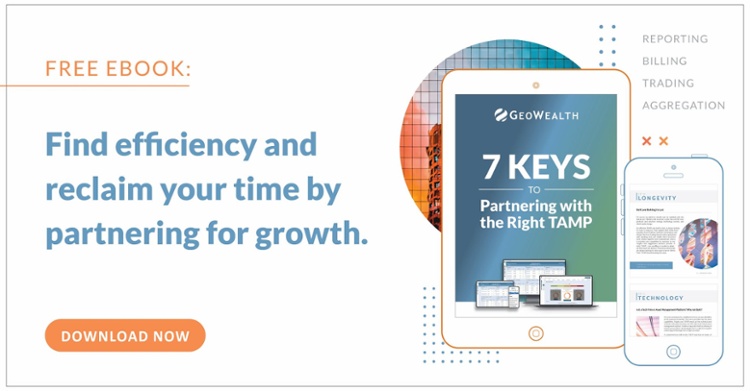Advisor Efficiency: The Secret to a Differentiated Client Experience
Client Experience • Written by: Brendan Falls, CFP®

Finding Your Express Lane
There’s certainly no question that today’s advisors understand the importance of creating an exceptional client experience.
And especially with investor emotions and concerns rising as a result of the inflation, rising interest rates, global unrest and pandemic uncertainty we’ve experienced over the past few years, not to mention the potential recession looming on the 2023 horizon, what clients are looking for most right now is peace of mind from the financial professional they trust the most.
In practice, that translates into meaningful, substantial time spent reviewing performance, fielding questions, adjusting projections and generally acting in a financial therapist capacity.
The desire to meet these expectations isn’t the problem. In fact, a recent Broadridge study reports that a majority of financial advisors want to spend more time with clients and on comprehensive financial planning, and less time managing investments. Of those surveyed:
- 62% want to spend more time with clients
- 43% on more comprehensive financial planning
- 42% want to spend more time on client acquisition
But according to Kitces research, financial advisors spend barely 20% of their time actually meeting with clients – which can cause significant damage to both the client experience and an advisory firm’s bottom line.
Consider that research from Invesco indicates that 72.2% of financial professionals lose one top client per year, and according to our own data, for most firms, the great majority of AUM comes from a small subset of clients. Losing just one of them could mean a substantial hit to revenue during a time when profitability is already down across the board.
Dave Zoller, CFP, of Streamline Financial, reports that clients are looking for at least 10 meaningful interactions per year from their financial advisor, and that advisors who exceed those 10 touch points make an average of 68% more than those who don’t hit double digits.
The case for time with clients is well established. But how do advisors, especially those who are playing a dual role as business owner, meet all of their additional responsibilities – staying on top of compliance regulations, vetting and maintaining technology, marketing, trading, billing, reporting, recruiting and hiring – in such a way that enables them to dedicate the majority of their time to client activity?
It’s a matter of prioritization, business analysis, and some outside-the-box thinking.
Determine Where and How You Provide the Most Value
Most likely, as we’ve discussed, your greatest value is the time you spend with your clients. In a NASDAQ report that compiled what clients are looking for most from their relationship with their advisor, these seven components rose to the top:
- Understanding
- Respect
- Integrity
- Accessibility
- Education
- Holistic Problem Solving
- Competence
For the most part, meeting the expectations on this list requires an investment of time that enables deeper than surface-level relationship building.
In addition to getting to know your clients, their families, their goals and their potential challenges, building holistic financial plans and even investment management may round out your unique value proposition, or why your clients picked – and stayed with – you over another advisor.
Whatever your core competencies are, defining them will also quickly surface the activities that aren’t directly contributing to client experience and firm growth.
Identify Costly Inefficiencies
Where are you spending significant time on tasks and processes that aren’t directly related to the value you bring to your clients?
Processes like onboarding, if not fully automated, can mire advisors down in administrative tasks – paperwork, investment proposals, account opening and asset transfers.
And while most firms are moving toward a digital-led onboarding experience to save time and resources, ongoing administrative operations thereafter like billing, reporting and especially trading can be considerable drains on advisors’ time.
Explore New Operational Avenues
Let’s take trading as an example of an advisory time bandit – an essential task that doesn’t contribute directly to revenue or to the client experience.
For most RIAs, trade type volumes are heavily weighted toward recurring maintenance trades – ongoing contributions and distributions – and far less so toward new investments, where a client is investing in a brand new allocation or changing their current allocation.
And while new investments certainly require administrative oversight and attention, ongoing or one-off maintenance trades are simple and straightforward. But because the volume of those trades is so high, manually executing them becomes a serious operational burden.
The easiest answer to this challenge would be to offload maintenance trades to an administrative employee. But thanks to the effects of the current market, advisors are facing decreased revenue even if they’re continuing to add clients to their book of business, meaning that increasing the business’s fixed costs in the form of employee salaries and benefits is probably not the right move.
To save on costs while gaining the efficiencies that drive the time necessary to consistently deliver an exceptional client experience, consider leveraging an outsourced partner.
Offloading middle- and back-office tasks that fall outside of your core competencies to an outsourced solution significantly reduces your operational burdens without adding salaries and benefits to your list of fixed costs.
As a flexible outsourced platform, GeoWealth will work with you to determine which tasks make the most sense for you to retain in house, and which would be best outsourced to our team of experts. And because we act as a partner, you can rely on our world-class service and support as you continuously re-evaluate your priorities to align with business and client goals.

